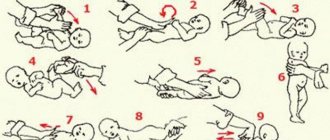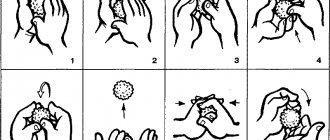Children under 3 months old can communicate! The first months of a child's development are an exciting time for parents, as babies at this age make significant progress in communication. Just imagine bringing home a stupid little one, and within a few weeks you will be able to enjoy two ways of “conversation” at once - exchanging smiles and “ooh-ah-ah-hoo-hoo”. You will see how your child's personality clearly manifests itself, how your baby becomes more active and the most demanding member of the family.
In this article we will talk about everything that concerns communication with children aged 1 to 3 months. We will teach you to understand newborns and speak to them in “children’s” language. You will also learn how to develop communication skills in a baby.
Communication with babies
As mentioned above, communication with a child begins from the first day of life. In the early stages, while the baby cannot express his emotions and speak, crying is his main means of communication for many months. This is how children let their parents know that they need something, that something hurts them. Children may also cry when they are tired, frightened, or are disturbed by something, such as a sharp sound. Sometimes babies may cry for no apparent reason. While your child is not yet too upset, try to console him; this approach will prevent the nervous system from being shaken.
Very quickly the child will react to the sound of your voice, smiling quietly or, conversely, excitedly moving his arms and legs. Children of this age at first smile only at their parents, but after a while they will begin to react to less familiar people.
Newborns very quickly reveal their ability to communicate by starting to coo. Some babies begin making vowel sounds (such as “Ahh” or “ooh-oh”) around 2 months of age. Learn to understand your child - he will “speak” to you in different sounds, he will smile, frown or cry. All these actions will be aimed at only one goal - to get your answer. And some children are so receptive that they can copy the facial expression of their interlocutor.
What to talk about with a silent interlocutor
Interesting: Dwayne Johnson showed how he does his daughter’s hair, and followers are delighted. Now he's only a stylist
A full dialogue with the baby will not work, but he will very quickly begin to make some sounds in response.
Mom can simply comment on all the actions and manipulations that she performs during the day. Starting from “woke up, stretched” and ending with “time to sleep.” If she has to go out, for example, to take a shower and leave the baby alone, this also needs to be voiced.
And now the main thing: there is no shame in cooing with a baby!
This is a very useful practice, because at this age it is not the words themselves that are important, but their emotional coloring and the mood of the speaker. It is in cooing over the baby that mothers invest their love.
And the babies with whom they lisped in infancy knew twice as many words as those with whom they spoke “in an adult way.” This conclusion was reached by scientists from the University of Edinburgh, who presented the results of relevant work in the journal Science Daily.
Mom can talk about her feelings, even share that she is tired. This will be her initial contribution to the development of emotional intelligence. If she is alarmed, let her explain the reasons for her condition to a child who is closely connected with her and feels the same as she does. And he may even consider himself the cause of negative experiences.
What needs to be done when communicating with a child 1 - 2 - 3 months old so that he develops
Any child loves to listen to the voice of his mother, so you need to constantly talk, sing and coo to him as often as possible during the first few months. Respond enthusiastically to all sounds and smiles. Talk about what you do, what you bring and what you touch.
Give your child the opportunity to communicate and help him. If you hear him make a sound, repeat and wait for a new reaction. Without knowing it, when talking, you teach your baby to change his tone, increasing or decreasing it for a specific purpose. By answering, you let the baby know that you hear him and he is important to you. Do not interrupt the conversation or look away when the baby “talks” - show that you are interested.
Children of this age respond best to a woman's voice, as it is genetically linked to comfort and food. However, everything is not so simple here, understanding that in fact there is also a reasonable factor here, you lay the groundwork for the first words.
Sometimes babies are not in the mood to talk or sing, because they are also tired and need peace and short-term solitude. This condition can be determined by behavior - the child turns away, closes his eyes, or becomes fussy or irritable. In such cases, be silent and simply hug him, taking him in your arms.
How to talk to a child
Speech should be as intonated as possible. The baby is already learning to understand when others are having fun and when they are sad. Therefore, he will not like monotonous muttering. A newborn is already, in fact, a “speaking creature”; he actively learns the world through hearing, so he can show by shouting how to talk to him. He literally absorbs the speech of his parents.
Neuropsychologists confirm that constant casual conversations about what is happening activate the work of different parts of the brain.
After just a couple of months, the child begins to respond to his mother’s speech by humming. He joins the dialogue. From this moment on, you need to speak not to him, but to him, giving him the opportunity to insert his “word.” Thanks to this, some children already from the age of six months try to repeat simple syllables: “ba”, “ma”, “pa”.
When communicating, you need to use the present tense.
It also helps perception. The baby does not yet understand such things as the past and the future. But he listens to the conversation in the present tense with a more meaningful look.
If a newborn baby is naughty
By the way, a child’s cry is not always a bad thing either; it has been proven that pushing helps release excess gases and develops the lungs. And screaming is a way to give away excess energy.
It is common for babies to have a designated period of time to “cry”, usually at the same time every day, usually between early evening and midnight. Although all children cry and show some fussiness, you need to contact a neurologist if the child screams unreasonably for more than 3 hours a day (in total), more than 3 days a week. Anything less than this threshold is normal, since the baby may be bothered by colic. This condition ceases at approximately 3 or 4 months of age. You can also help your child cope with abdominal pain.
When the screaming starts, try to calm your baby down. Some babies are soothed by rocking or walking back and forth across the room, while others respond well to sounds such as soft music, a bell, or the hum of a vacuum cleaner. Find out what your baby likes best and use the method during crying periods.
Child 2.5-3 months
The duration of wakefulness increases. At this stage, the formation of visual and auditory orienting reactions plays a very important role in the development of the child. A so-called situational business form of communication is emerging.
How should a mother communicate with her baby at this stage of his development?
During waking hours, organize activities with simple toys - rattles, bells, bells, lasting 1-3 minutes. They will teach your baby to follow a moving toy with his eyes and focus his gaze on a stationary one hanging above him. At this age stage, the child begins to pronounce the first sounds in his life, they are called gurgling, they arise when pronouncing the sounds “gee”, “khi”. Their appearance will please parents, since they are a preparatory stage for further mastering the sounds of their native language. Continue to teach your baby to listen to his own and other people’s speech, and to turn his head towards the sound. To do this, talk to him gently and melodiously, using an affectionate and cheerful tone.
What toys will be needed for the baby's development?
At this age, there is no need to overwhelm your child with expensive gifts and toys - he doesn’t need them. It is enough to purchase a few bright items that have the following functions.
toys for babies
Bright and safe bracelet for babies with Velcro . The toy rings, rustles, is pleasant to the touch and very bright. With such a bracelet, the baby will examine the hands, developing vision, hearing, and over time, tactile skills. The issue price is 210 rubles, including delivery.- Musical massager – teether “Baby Elephant” . He “sings” quietly, you can “gnaw” him, touch his ears - they rustle. The bright and cheerful toy can be hung. The baby elephant costs 320 rubles including delivery.
- Colored finger puppets “Jolly Zoo” . Price for 10 pieces - 390 rubles.
You can get acquainted with the best educational toys for infants in the section “Educational toys for babies up to 6 months.”
Developmental activities
Regardless of how you feel about early development, you need to engage with your child from the very first day of his life. Learning is a natural process that requires not only a student, but also a teacher. Mother and child act as allies who master this world and help each other learn something new and interesting. You should immediately choose the role you want to play for your child. You can become a friend, a mentor, a strict teacher, or a loving and pampering mother. It is also possible to combine all these roles, but your overall strategy for education should not differ. Choose the tone with which you will teach your child something, practice the intonation with which you will sing songs and tell your child fairy tales. You must do a lot of work on yourself in order to be able to try on in your soul several different personalities who want to develop the child in different directions.
When to take your newborn to the doctor
Talk to your doctor if your baby cries for an unusually long time or if his cries seem strange to you. The doctor will likely not find anything wrong, but knowing your pet is healthy will help you relax and stay calm if he is upset.
From birth to 3 months, children typically achieve the following achievements:
- pay attention to faces and surrounding objects;
- smile at the sound of their parents' voices;
- smile at strangers if they treat the baby kindly and they like the person’s voice and smell;
- coo and make noises when spoken to;
- imitate some sounds and facial expressions.
When studying and comparing your child's abilities, keep in mind that all babies develop differently, and this also applies to physical parameters. Mild differences in standards are not cause for concern, but it is important to talk to your doctor if you have any questions about your child's language or hearing skills.
The period before the birth of the child
Physiologists have established that even before the moment of birth, the fetus develops all types of sensitivity, muscular system, etc. The process of maturation of the nervous system is underway. And the speech center is most susceptible to negative influences. A child lives in the womb - he hears words, music, and singing addressed to him and those around him. Talk to your baby, tell him that his birth is highly anticipated and he is loved.
Now let’s take a closer look at what capabilities a baby has and what he can learn after birth.










